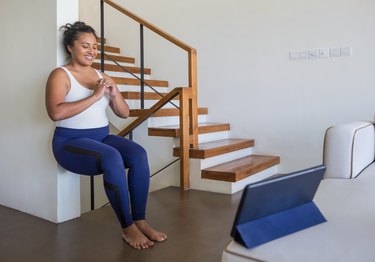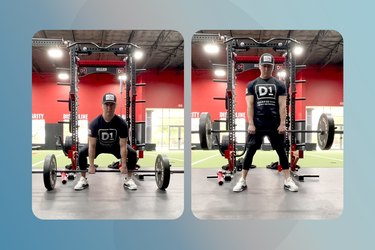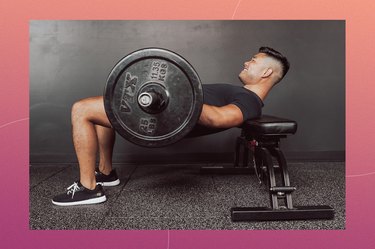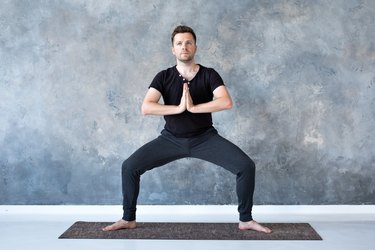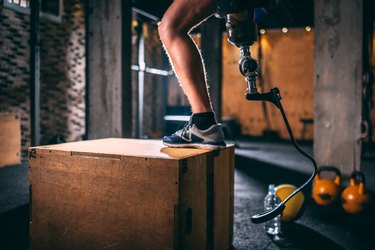

The step-up exercise is a seemingly humble exercise: Climb a step, then come back down. But that simple movement has effectiveness superpowers. It fires up the glutes and legs in a way that rivals (and sometimes, even surpasses!) classic lower-body moves like squats and lunges.
- What is a step-up? A unilateral, or single-leg, exercise that involves placing one leg on a step or bench, then pressing through that leg to bring your other foot up to meet the lead one.
- What muscles do step-ups work? The main step-up exercise muscles worked are your quadriceps, glutes and hamstrings. Other muscles get involved as stabilizers, but the big leg muscles do the most work. Your core muscles keep you steady.
- What can I use for step-ups at home? A staircase! You don't need a bench or aerobic step to do step-up at home. Live in a single-level home? A sturdy chair can work, too. (Just make sure that you're stepping into the middle of the seat, and not the edge, to keep the chair balanced.)
Video of the Day
Here's everything you need to know about what step-ups are good for, how to do them properly and variations to add to your routine.
How to Do the Step-Up Exercise With Proper Form
- Stand holding dumbbells at your sides, palms facing in. Place your left foot up on a step, bench or box so that your left knee is bent round 90 degrees.
- Pull your shoulders back and down as if you were trying to tuck your shoulder blades into the back pocket of a pair of jeans. Fill your chest with air to set your core, and maintain a tight, rigid core throughout the movement.
- Bring the weights forward slightly by leaning your torso forward just a bit. This will keep the weight in your front, working leg.
- Press through the heel of your raised foot and push your body up until your left leg is straight. Do not bring your right foot onto the bench until it is even with your left foot.
- Control your body as you lower your right foot back to the floor and return to the starting position. Complete all your repetitions on this side, then switch sides and repeat.
How Many Step-Ups Should I Do?
The best number of reps and sets to do depends on your fitness goals. If you're working to build muscle endurance, you might be able to crank out 15 or so reps, and do 2 to 3 sets. If you're working for strength and muscle gains, try using a moderately heavy weight and aim for 6 to 12 reps and 2 to 6 sets. If you're going really heavy, try to do 6 or fewer reps and 2 to 6 sets.
Watch the Full Tutorial
Related Reading
Step-Up Exercise Benefits and Muscles Worked
1. It Builds Glute Strength (Better Than Squats)
Your glutes include three muscles — the gluteus maximus, gluteus medius, and gluteus minimus — and this exercise hammer them all. In fact, in a June 2020 study in the Journal of Strength and Conditioning Research, step-ups were better at working the maximus and medius better than regular squats.
The maximus is the largest glute muscle, while the medius (also called the glute med) is the critical side-glute muscle that stabilizes your hips and knees when you do forward movements like walk, run and bike.
2. It Rocks Your Hamstrings (Better Than Squats)
Your hamstrings — a group of four muscles that run down the back of your thighs — play a role in most lower-body movements. They make it possible for you to move your knees and hips and rotate your thighs. And they work with the glutes to give you awesome lower-body strength.
Turns out, stepping up and back down is a great way to target this area. The above Journal of Strength and Conditioning Research also found that the exercise works the biceps femoris — one of the main hammies — harder than regular, two-legged squats.
3. It Makes Climbing Stairs a Breeze
Stronger quads, here you come! When your knee straightens against resistance (from gravity and the weight you're holding) your quadriceps in the front of your thighs fire. This makes it an excellent move for working and building the quads — and helping you more easily climb stairs.
Want to challenge your quads even more? The higher the step you tackle, the harder your quads will have to work to straighten your knee.
4. It Requires Minimal (if Any!) Weight
One of the big benefits of any single-leg exercise is that you need less weight to challenge your muscle. Get this: Because you're using one leg at a time, stepping up without any weights is similar to performing a two-legged exercise holding your entire body weight in dumbbells.
So if you're working out at home or don't have access to heavy weights, don't worry. You can still give your muscles a big challenge. Bonus: Single-leg moves require your core to work hard to keep you stable, so you'll be getting a sneaky core workout as you step.
5 Form Tips for Better Results
1. Get the Right Knee Angle
Choose a step or bench that allows your knee to be bent 90 degrees and at hip height, or even a little higher.
"You want to feel a stretch in the back portion of the hamstrings and the inner portion of the groin before the execution starts," Brandon Lirio, CPT, a certified personal trainer, director of BattleGround Fitness and a professional bodybuilder, tells LIVESTRONG.com.
If your knee is too low, the movement will me more similar to a quarter-squat than a full squat, and you'll be more likely to push up with your non-working foot to get the movement going.
That said, this is only if you find this setup comfortable. If a high bench or step feels uncomfortable on your knee, go ahead and work with a lower surface. Over time, you may be able to use higher and higher steps. If not, that's still cool.
2. Don't Use Your Back Leg
During this exercise, many people don't feel a ton of work in their raised leg because they spring off the non-working leg. Avoid this by focusing on your top leg, keeping your body weight out of your back leg and lowering slowly and only until your toes touch the floor.
3. Shift Your Weight Slightly Forward
When you place your foot up on the step or bench, the muscles that you want to work are now about a foot in front of the weight you're lifting — the weight being your bodyweight or your body plus a dumbbell or kettlebell. If you were to step up perfectly straight in this position, the weight will still be behind your working foot, and you're likely to just topple back down, Lirio says.
Instead, lean your torso and the weights slightly forward before each rep. This way, the weight will go up and down in what's closer to a straight up-and-down motion. This will also help keep you from pushing off with the back, non-working leg, and make sure the raised leg is doing all the work.
4. Lower Slowly
You might be tempted to only focus on the stepping up part of the move, but you want to also be mindful of how you step down. Slamming back down onto your non-working foot and ankle isn't going to feel so good, and there's no reason to subject yourself to all that impact — even if it doesn't hurt in the moment, your joints won't like it in the long term.
Avoid dropping onto your non-working leg by lowering your body in a slow and controlled motion.
5. Do All Reps, Then Switch Legs
As with any exercise, it's important to nail proper form before progressing it (adding more weight or a higher step). Doing all of your reps on one side and then switching to the other leg means you don't have to reset after every single rep, making it easier to keep your form locked in. (It also means a lot less coordination is required!)
You'll also keep the muscles under tension for longer, which translates to more gains.
Related Reading
The 3 Best Variations
Mix things up — or even build an entire step-up box workout — with these must-try variations.
Move 1: Body-Weight
This is an ideal step-up exercise for beginners — or anyone who wants to strengthen up without equipment.
- Place your left foot up on a step, bench or box so that your left knee is bent about 90 degrees.
- Pull your shoulders back and down as if you were trying to tuck your shoulder blades into the back pocket of a pair of jeans. Fill your chest with air to set your core, and maintain a tight, rigid core throughout the movement.
- Lean your torso forward just a bit. This will keep the weight in your front, working leg.
- Press through the heel of your raised, left foot and push your body up until your left leg is straight. Do not bring your right foot onto the bench until it is even with your left foot.
- Control your body as you lower your right foot back to the floor and return to the starting position. Complete all your repetitions on this side, then switch sides and repeat.
Move 2: Kettlebell Goblet
This variations works your quads even harder!
- Stand holding a dumbbell in front of your chest vertically. Your hands should cup the head of a dumbbell, like you’re holding a goblet. Place your left foot up on a step, bench or box so that your left knee is bent about degrees.
- Fill your chest with air to set your core, and maintain a tight, rigid core throughout the movement.
- Bring the weight forward slightly by leaning your torso forward just a bit. This will keep the weight in your front, working leg.
- Press through the heel of your raised, left foot and push your body up until your left leg is straight. Do not bring your right foot onto the bench until it is even with your left foot.
- Control your body as you lower your right foot back to the floor and return to the starting position. Complete all your repetitions on this side, then switch sides and repeat.
Tip
Lean your torso slightly forward to keep the kettlebell stacked directly over your lead foot's heel. This will make it easier to raise up. Just make sure to keep your back flat (no arching or rounding!).
Move 3: Lateral
The lateral step-up engages the glute medius, the muscle on the side of the butt that is crucial for stabilizing the leg when you do lower-body movements. It also plays a major role in hip abduction, which happens when you lift the leg out to the side and away from your body.
The move is one of the very best exercises for targeting this important hip muscle, per a December 2020 International Journal of Sports Physical Therapy study.
- Stand with your left side next to a step, bench or box, holding holding dumbbells at your sides at arm’s length, palms facing in. Place your left foot up on the step so that your left knee is bent about 90 degrees.
- Pull your shoulders back and down as if you were trying to tuck your shoulder blades into the back pocket of a pair of jeans. Fill your chest with air to set your core, and maintain a tight, rigid core throughout the movement.
- Push your body up, pressing through through the heel of your raised, left foot and push your body up until your left leg is straight and your right foot is at the same level as your left foot.
- Control your body as you lower your right foot back to the floor and return to the starting position. Complete all your repetitions on this side, then switch sides and repeat.
More of the Best Leg Exercises
- International Journal of Sports Physical Therapy: "A SYSTEMATIC REVIEW AND META-ANALYSIS OF COMMON THERAPEUTIC EXERCISES THAT GENERATE HIGHEST MUSCLE ACTIVITY IN THE GLUTEUS MEDIUS AND GLUTEUS MINIMUS SEGMENTS"
- Journal of Strength and Conditioning Research: "Muscle Forces During the Squat, Split Squat, and Step-Up Across a Range of External Loads in College-Aged Men"
